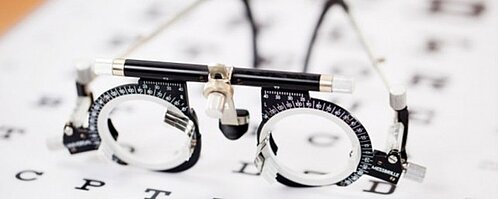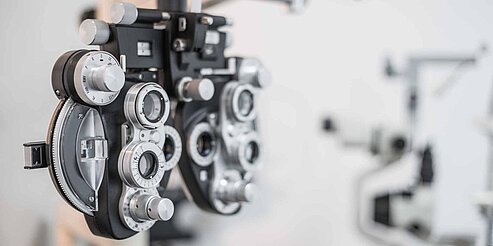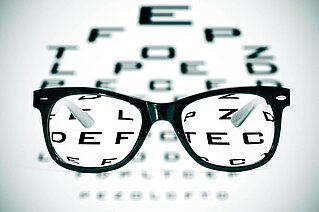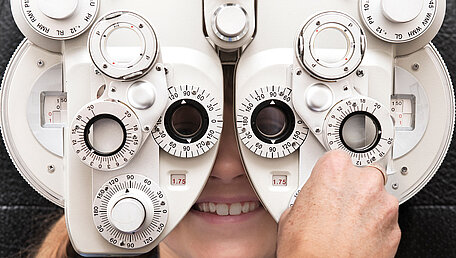Continuing education programme at the UL Faculty of Physics, Mathematics and Optometry offers courses dedicated to various topics of optometry. Courses are intended for optometrists and ophthalmologists who aspire to improving their qualification.
Continuing education courses are available in Latvian, English and Russian. The number of participants is limited (12–15 per group). For more information, please contact the coordinator of the Department of Optometry and Vision Science (email: aija.tolstoja@lu.lv).

Course code: RedZT002
Course annotation
The course is intended for those who have obtained bachelor's degree (or an equivalent education), in a different field but not in optometry, and are willing to enter the professional master's study programme Clinical Optometry. The aim of this course is to establish basic knowledge and skills in topics essential for starting studies in professional master’s study programme Clinical Optometry – geometrical optics, physical optics, visual optics, eye anatomy and physiology, refraction, eye diseases, binocular vision, contact lenses, optometric instruments. Each week is devoted to a different topic and concluded with a test. At the end of the course participant takes final test, which includes questions about all the topics covered during the course.
Learning outcomes
Upon completion of this course, participants will learn and will be able to demonstrate:
Knowledge:
- structure and basic principles of eye and visual system;
- basic principles of geometrical optics;
- basic principles of physical optics;
- basic principles of visual optics;
- refraction, principles of evaluation and prescription;
- various lens designs and properties;
- basic principles of visual perception;
- common eye diseases;
- foundation of binocular vision, its function in normal and abnormal development;
- parameters of contact lenses, their types, fitting, and care;
- common optometric instrumentation and their application in optometric practice.
Skills:
- to explain basic eye functions, e.g. accommodation, binocular vision, vision disorders, light adaptation, color vision;
- to calculate parameters of optical lens systems, image formation in optical systems, parameters of visual system;
- to describe various optical materials (glasses, contact lenses), their properties, types, designs, parameters;
- to distinguish common eye diseases.
Competencies:
- to calculate image formation in optical systems combining acquired knowledge and skills in geometrical, physical, and visual optics;
- to explain optical phenomenon appearing in optical systems and eye;
- to explain the function of the visual system in various conditions, the importance of vision correction in various refractive conditions, as well as use of various vision correction types in classical conditions;
- to fortify the use of certain optical material and vision correction in classical conditions.
Requirements for awarding credits:
In order to receive certificate, participants must master a definite volume of materials each week, pass weekly tests and final examination (a written test). The final grade is calculated from the average (arithmetic) evaluation of 15 tests (60%) and final examination (the written test) (40%). The assessment required for successful acquisition of this course is 4–10.

Day 1
Theory: different methods for estimating spherical and cylindrical correction: nebulisation method, duochrome test, three different methods of using a crossed cylinder, methods for determining dominant eye (motor and sensory), binocular balance, use of spherical equivalent in vision correction, correction with different types of lenses, anisometropia and aniseiconia.
Application: assessment of astigmatism, crossed cylinder using methods, evaluation of myopia and hypermetropia, binocular balance, evaluation of anisometropia, static retinoscopy, spherical equivalent and changes in cylinder power.
Day 2
Theory: assessment of binocular vision (occlusion test, Maddox test), effect of eye refraction on binocularity, various tests of stereo vision assessment, assessment of binocular vision types, assessment of binocular vision in children, assessment of strabismus. Assessment of accommodation – accommodation amplitude, accommodation reserves, accommodation ease, dynamic retinoscopy.
Application: assessment of accommodation and binocular functions using different methods.
Day 3
Theory: step-by-step assessment of visual functions. Differential diagnosis of paediatric refraction.
Application: assessment of real patients' vision.

Day 1
Theory: sensory system disorders (diplopia and confusion), adaptation of binocular system (suppression and abnormal retinal correspondence). Sensory system evaluation (suppression tests and stereotests).
Application: sensory system assessment – suppression evaluation tests (VORS test, Schober’s test, red glass test, Bagolini test) and stereo tests (TNO test, Titmus test, Lang test, etc.).
Day 2
Theory: motor system disorders (vergence disorders, eye movement problems, strabismus). Motor system assessment methods.
Application: assessment of head position, convergence, assessment of eye movement muscle function, evaluation of strabismus angle (Hirschberg test, Krimsky test, occlusion test, prism occlusion test, Maddox test, von Graefe technique), assessment of fusion reserves.
Day 3
Theory: inclusion of binocular function assessment during the assessment of the patient's general condition, interpretation of results.
Application: assessment of binocular function in patients with binocular visual impairment.

Day 1
Theory: vision examination plan for presbyopic patients. Changes in accommodation with aging. Determination of additive.
Application: evaluation of accommodation for presbyopic patients, different methods of additive determination.
Day 2
Theory: monofocal, bifocal, advanced, office-type and anti-fatigue spectacle lenses. Step-by-step plan for prescribing advanced spectacle lenses. Common problems with prescribing progressive glasses. Steps to eliminate complaints caused by progressive glasses.
Application: visual field assessment using different types of lenses.
Day 3
Theory: fitting of progressive glasses – pantoscopic angle, angle of curvature, vertex, frame adjustment. Different methods for making progressive lens height marks. Progressive lens mark restoration.
Application: determining distance between pupils, marking progressive lenses, adjusting frame for progressive lens insertion.

Day 1
Theory: classification of refractive errors and possibilities for diagnostics. Assessment of anterior segment structures. Subjective refraction assessment.
Application: methods for assessment of refractive errors.
Day 2
Theory: assessment of near vision functions. Introduction to contact lenses. Patient examination of applicability for contact lenses. Basic principles of fitting and prescribing spherical contact lenses.
Application: tear film assessment. Fitting and evaluation of spherical contact lenses with biomicroscope.
Day 3
Theory: assessment of anterior segment with biomicroscope. Basic principles of fitting and prescribing astigmatic and multifocal contact lenses. Contact lens care and storage. Complications caused by contact lenses.
Application: fitting of astigmatic and multifocal contact lenses. Assessment of anterior structures with biomicroscope.

 Academic Centre
Academic Centre